Making food look appetizing is more than half the battleof getting children to eat. You can be sure if the food doesn’t look appetizing, children’s first reaction will be to spurn it. Trying to convince them to taste something they previously turned up their noses at is exhausting and time-wasting. Instead, just try to make it look as good as you can from the beginning.
We learned early on that our kids did not seem to relate to foods that are brown, except for chocolate and beef, of course. Might the fact that our daughter became a vegetarian at age 9 have to do with the fact that beef is brown when cooked? We don’t know, but we put garnishes on soups (like sour cream, cheddar cheese, chopped parsley, other chopped herbs, etc.) that were brown just to change the presentation and spare ourselves the grief.
So as you start to teach kids to cook, make sure you add generous sprinklings of lessons in presentation.
The TV chefs do a wonderful job of presentation, so when watching cooking shows with kids, remark about how pretty he or she made the food when it was time to serve it. That’s what “presentation” means. Explain that making food look attractive to eat makes people who will eat it feel really good.
Cut up some fruit for breakfast or for dessert for any meal and ask your child to arrange it in the prettiest way possible on a plate. You can show your child that dumping the fruit on the plate doesn’t look appetizing, so maybe your child can help make it pretty.
The child may make it into a face; that’s fine as long as it looks appetizing. Any design will do and the more complicated designs will only be possible as your child ages and matures.
One important element of design is to group like things. As in the picture above, the blackberries, persimmons, and pears are all individual units, but each group is doing the same thing as other members of its group.
Teach them that when you scoop something onto a plate, do it neatly and gently so the food doesn’t scatter all over. Then you will be respecting one of the basic tenets of eating as a child: don’t mix foods! Kids seem to like the individual tastes, but not the collective tastes, so it’s safer to keep different foods in discrete spaces on a plate.
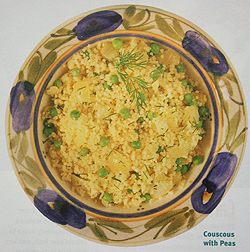 Teach children that sometimes less is better, especially if you arrange things neatly.
Teach children that sometimes less is better, especially if you arrange things neatly.
Notice that the peas in this dish are evenly spaced across the top and only one sprig of dill is necessary to make it look attractive and special.
Kids get the concept of “special” pretty early on, so use that term to convey the concept of presentation (as “special”).
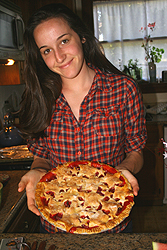 Pie crusts are for the brave parents, but if you’re teaching them to kids, encourage them to use their imaginations for the top crust.
Pie crusts are for the brave parents, but if you’re teaching them to kids, encourage them to use their imaginations for the top crust.
Use cookie cutters to cut out clever designs to place together as the top crust. As long as they overlap somewhat, the pie will have a coherent crust that will stay together. The teenager in the picture cut out large and small stars and placed them carefully over the surface to make a very creative crust.
Garnishes for Presentation
Herb garnishes can make dreary things come to life with taste and look fresh and appetizing, too. Chopped cilantro, flat-leaf parsley, tiny thyme leaves, and torn basil leaves add flavor, get your children to eat leafy greens, and make things look special. Not too much; just a small clump in the middle or leaves laid carefully over the surface will do. You get the picture and so will your child.
Paprika sprinkled in a streak across the top of a cheese casserole dish provides wonderful contrasting red color over the paler colors of cheeses and pastas.
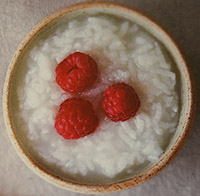 Fruit placed judiciously on breakfast grains or porridges make a simple and elegant statement. This image comes from a wonderful cookbook called The Chopsticks Diet by Kimiko Barber and demonstrates how simple yet powerful presentation can be. Find it on Amazon.
Fruit placed judiciously on breakfast grains or porridges make a simple and elegant statement. This image comes from a wonderful cookbook called The Chopsticks Diet by Kimiko Barber and demonstrates how simple yet powerful presentation can be. Find it on Amazon.
The Japanese do wonderful things with garnish. For example, tiny carrot slices peeled and curled and placed on top of salads or meat look and taste great. Sesame seeds sprinkled over a rice, fish, or tofu meal makes an attractive dish.
Keep It Simple!
This is all about cooking with kids, so, while you encourage children to do creative presentation, keep it simple. Depending on their ages, they will tire of the effort if it takes too long or is too complicated.

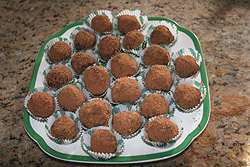
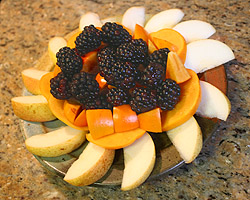
I bow down humlby in the presence of such greatness.